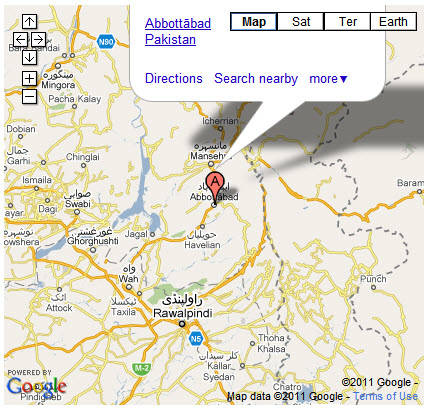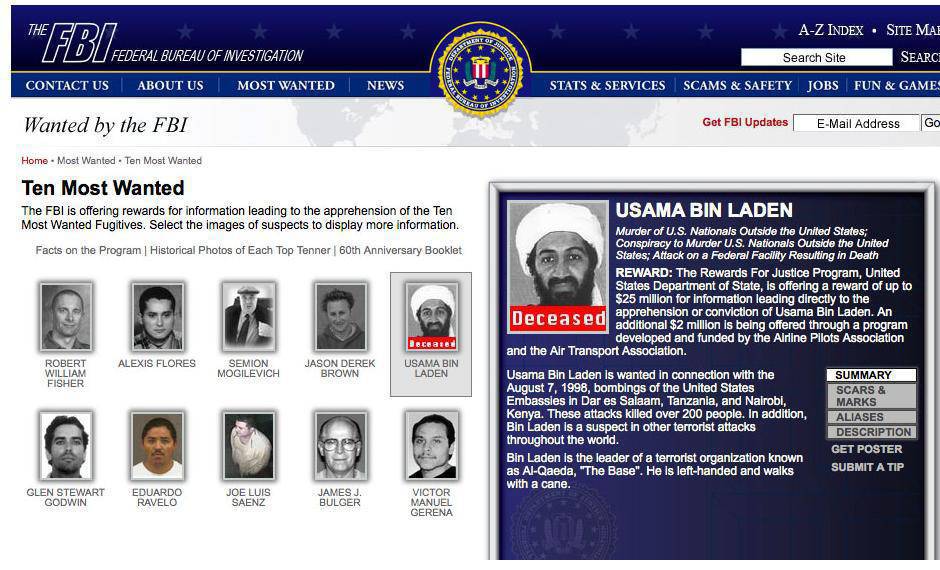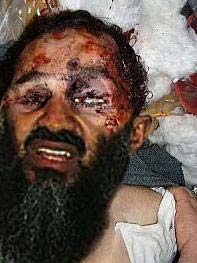http://www.smh.com.au/world/osama-bin-laden-dead-20110502-1e44h.html
Osama bin Laden dead
Simon Mann
May 2, 2011 - 2:34PM
Osama bin Laden dead: Obama
US President Barack Obama announces the death of the mastermind of the September 11 attacks on the World Trade Centre in 2001.
Video feedbackVideo settingsMore video
Recommended
Click to play video
Osama bin Laden slain: Obama
Click to play video
Osama bin Laden dead: Obama
Click to play video
Hong Kong Airlines practise Wing Chun
Click to play video
Obama ribs Trump at correspondents' dinner
Replay video
Tap F5 on your keyboard to see the latest
US team kills terrorist leader in firefight
Attack on Pakistan hideout today
US has bin Laden's body
Full coverage
US President Barack Obama has confirmed the death of the world's most wanted man - Osama bin Laden.
A top secret operation involving US special forces was responsible for an attack on bin Laden’s hideout early today.
Advertisement: Story continues below
US Department of State and FBI released this "age progressed" photograph of Osama Bin Laden last year.
Obama said last week he authorised the operation to get bin Laden from his hiding place at Abbotabad, about 60km from Rawalpindi in Pakistan and a gateway to the spectacular Kagan Valley.
"After a firefight they killed Osama bin Laden and took custody of his body" he said.
Mr Obama offered little details about the attack, but said Pakistani intelligence sources had been supportive of the operation.
Click for more photos
Osama bin Laden killed
People cheer and wave US flags outside the White House. Photo: Reuters
US media reported that bin Laden was killed by military personnel from the US Joint Special Operations Command's Special Mission Units.
Navy SEALs from the Naval Special Warfare Development Group DEVGRU, an elite counter-terrorism unit were reported to have carried out the operation on the ground backed up by an RQ-170 drone overhead, the White House correspondent for the National Journal, Marc Ambinder, said.
The whole operation took about 40 minutes, CNN reported, citing its sources.
View Larger Map
Crowds cheer outside White House
The stunning news was announced from the east room of the White House late on Sunday evening in a live TV broadcast (about 1.40pm Monday AEST) as crowds cheered outside.
"Justice has been done," he told the American people. "Today's achievement is testament to the greatness of our country."
Mr Obama said that after the atrocity of September 11 in 2001, Americans were united in their resolve to go to war against al Qaeda.
He said he made the killing or capture of bin Laden his top priority on taking office.
''The death of bin Laden marks the most significant achievement to date in our nation's efforts to defeat al Qaeda,'' the president said.
''Yet his death does not mark the end of our effort.
''There is no doubt that al Qaeda will continue to pursue attacks against us.
''We must and will remain vigilant at home and abroad.''
Obama reaffirmed that the US was not at war with Islam.
''I've made clear just as President Bush did shortly after 9/11 that our war is not against Islam. Bin Laden was not a muslim leader, he was mass murderer of Muslims.''
''So his demise should be welcomed by all who believe in peace and human dignity.''
Cooperation with Pakistan
Obama said cooperation with Pakistan had helped lead the US to bin Laden in Abbottabad, which was named after Major James Abbott, the first British Deputy Commissioner of Hazara, who founded the city in 1853.
The Saudi-born leader of al-Qaeda had been hunted since a series of attacks on Western targets including the September 11, 2001, attacks in New York and Washington that levelled the twin towers of the World Trade Centre and hit the Pentagon.
It has been nearly 10 years since the attacks on the World Trade Centre and the Pentagon, which bin Laden was accused of masterminding.
Bin Laden, a Saudi national, is believed to have established terrorist group al-Qaeda, which means ''The Base'' in Arabic, in 1998.
He used his family's wealth - accumulated through Saudi Arabia's oil boom - to set up training camps in Afghanistan and to plan attacks against other countries.
He has been blamed for other terrorist attacks, including the bombing of the US embassies in Kenya and Tanzania in 1998 and the 2000 bombing of the destroyer USS Cole in Yemen.
US congressional and administration sources said US officials had the body of bin Laden.
Following the attacks on the US, the US led a coalition of military forces to overthrow the Taliban - who refused to hand over bin Laden - in Afghanistan.
A manhunt for bin Laden by the US has continued for the past decade following a massive military assault in the mountains of Tora Bora in 2001.
Most wanted
Bin Laden was on the FBI's 10 Most Wanted Fugitives list and a reward of $US50 million had been offered by the US Department of State for information leading to his capture.
The news brought a cheering, chanting crowd outside the White House fence.
He has been the subject of many news stories reporting his death since 2001.
The first prominent report came in December 2001, when Fox News picked up a Pakistan Observer article that bin Laden died of untreated lung complications in Tora Bora, a cave complex in the mountains of eastern Afghanistan.
During the following 10 months a number of people, including then-US defense secretary Donald Rumsfeld, Afghanistan President Hamid Karzai, CNN talking head Sanjay Gupta and Pakistani President Pervez Musharraf, speculated that the terrorism chief was missing or probably dead.
Three years later, in April 2005, ANU terrorism expert Clive Williams said he believed bin Laden died of organ failure in April 2004.
In September 2006 speculation came out of France that bin Laden had died from typhoid fever in Pakistan a month earlier.
The report, attributed to the French secret service, was played down by the defense minster and then-French president.
Pakistani politician Benazir Bhutto said in November 2007 that Omar Sheikh had murdered bin Laden.
The statement, made during an interview with David Frost, was not widely picked up on or pursued.
During the next four years a growing number of academics and South Asian political figures speculated bin Laden had been dead for a number of years.
- with agencies, Glenda Kwek, Georgina Robinson and Stephanie Gardiner
Read more: http://www.smh.com.au/world/osama-bin-laden-dead-20110502-1e44h.html#ixzz1LAPZa4OP



















